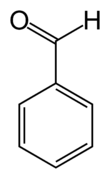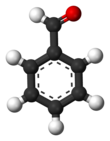Benzaldehyde(C6H5CHO) is anorganic compoundconsisting of abenzenering with aformylsubstituent. It is among the simplestaromaticaldehydesand one of the most industrially useful.
| |||
| Names | |||
|---|---|---|---|
| IUPAC name
Benzenecarbaldehyde
| |||
| Preferred IUPAC name
Benzaldehyde[1] | |||
| Other names
Benzenecarboxaldehyde
Phenylmethanal Benzoic aldehyde | |||
| Identifiers | |||
3D model (JSmol)
|
|||
| ChEBI | |||
| ChEMBL | |||
| ChemSpider | |||
| ECHA InfoCard | 100.002.601 | ||
| EC Number |
| ||
| KEGG | |||
PubChemCID
|
|||
| RTECS number |
| ||
| UNII | |||
| UN number | 1990 | ||
CompTox Dashboard(EPA)
|
|||
| |||
| |||
| Properties | |||
| C7H6O | |||
| Molar mass | 106.124g·mol−1 | ||
| Appearance | colorless liquid strongly refractive | ||
| Odor | almond-like | ||
| Density | 1.044 g/mL, liquid | ||
| Melting point | −57.12[2]°C (−70.82 °F; 216.03 K) | ||
| Boiling point | 178.1 °C (352.6 °F; 451.2 K) | ||
| 6.95 g/L (25 °C)[3] | |||
| logP | 1.64[4] | ||
| -60.78·10−6cm3/mol | |||
Refractive index(nD)
|
1.5456 | ||
| Viscosity | 1.321cP(25 °C) | ||
| Thermochemistry | |||
Std enthalpy of
formation(ΔfH⦵298) |
−36.8 kJ/mol | ||
Std enthalpy of
combustion(ΔcH⦵298) |
−3525.1 kJ/mol | ||
| Hazards | |||
| GHSlabelling: | |||

| |||
| Warning | |||
| H302 | |||
| P264,P270,P301+P312,P330,P501 | |||
| NFPA 704(fire diamond) | |||
| Flash point | 64 °C (147 °F; 337 K) | ||
| 192 °C (378 °F; 465 K) | |||
| Explosive limits | 1.4–8.5% | ||
| Lethal doseor concentration (LD, LC): | |||
LD50(median dose)
|
1300 mg/kg (rat, oral) | ||
| Safety data sheet(SDS) | J. T. Baker | ||
| Related compounds | |||
Related compounds
|
Benzyl alcohol Benzoic acid Benzaldehyde oxime | ||
Except where otherwise noted, data are given for materials in theirstandard state(at 25 °C [77 °F], 100 kPa).
| |||
It is a colorless liquid with a characteristicalmond-likeodor,and is commonly used incherry-flavoredsodas.[5]A component ofbitter almondoil, benzaldehyde can be extracted from a number of other natural sources.[6]Synthetic benzaldehyde is the flavoring agent in imitation almond extract, which is used to flavor cakes and other baked goods.[7]
History
editBenzaldehyde was first extracted in 1803 by the French pharmacist Martrès. His experiments focused on elucidating the nature ofamygdalin,the poisonous compound found inbitter almonds,the fruit ofPrunus dulcis.[8]Further work on the oil byPierre Robiquetand Antoine Boutron Charlard, two French chemists, produced benzaldehyde.[9]In 1832,Friedrich WöhlerandJustus von Liebigfirst synthesized benzaldehyde.[10]
Production
editAs of 1999, 7000tonnesof synthetic and 100 tonnes of natural benzaldehyde were produced annually.[11]Liquid phasechlorinationandoxidationoftolueneare the main routes. Numerous other methods have been developed, such as the partialoxidationofbenzyl alcohol,alkalihydrolysis ofbenzal chloride,and thecarbonylationof benzene (theGatterman-Koch reaction).[6]
A significant quantity of natural benzaldehyde is produced fromcinnamaldehydeobtained fromcassia oilby the retro-aldol reaction:[11]the cinnamaldehyde is heated in anaqueous/alcoholicsolution between 90 °C and 150 °C with abase(most commonlysodium carbonateorbicarbonate) for 5 to 80 hours,[12]followed by distillation of the formed benzaldehyde. This reaction also yieldsacetaldehyde.Thenatural statusof benzaldehyde obtained in this way is controversial.[11]
Occurrence
editBenzaldehyde and similar chemicals occur naturally in many foods. Most of the benzaldehyde that people eat is from natural plant foods, such asalmonds.[13]
Almonds,apricots,apples,andcherryseedcontain significant amounts ofamygdalin.Thisglycosidebreaks up under enzyme catalysis into benzaldehyde,hydrogen cyanideand two equivalents ofglucose.
Benzaldehyde contributes to the scent ofoyster mushrooms(Pleurotus ostreatus).[14]
Reactions
editBenzaldehyde is easily oxidized tobenzoic acidin air at room temperature,[15]causing a common impurity in laboratory samples. Since the boiling point of benzoic acid is much higher than that of benzaldehyde, it may be purified bydistillation.Benzyl alcoholcan be formed from benzaldehyde by means ofhydrogenation.Reaction of benzaldehyde with anhydroussodium acetateandacetic anhydrideyieldscinnamic acid,while alcoholicpotassium cyanidecan be used tocatalyzethe condensation of benzaldehyde tobenzoin.Benzaldehyde undergoesdisproportionationupon treatment with concentrated alkali (Cannizzaro reaction): one molecule of the aldehyde is reduced to thebenzyl alcoholand another molecule is simultaneously oxidized tobenzoic acid.
With diols, including many sugars, benzaldehyde condenses to formbenzylidene acetals.
Uses
editBenzaldehyde is commonly employed to conferalmondflavor to foods and scented products, including e-cigarette liquids. It is sometimes used in cosmetics products.[16]
In industrial settings, benzaldehyde is used chiefly as a precursor to other organic compounds, ranging from pharmaceuticals to plastic additives. Theaniline dyemalachite greenis prepared from benzaldehyde anddimethylaniline.Benzaldehyde is also a precursor to certainacridinedyes. Viaaldol condensations,benzaldehyde is converted into derivatives ofcinnamaldehydeandstyrene.The synthesis ofmandelic acidstarts with the addition ofhydrocyanic acidto benzaldehyde:
The resultingcyanohydrinishydrolysedtomandelic acid.(The scheme above depicts only one of the two formedenantiomers).
Niche uses
editBenzaldehyde is used as abee repellent.[17]A small amount of benzaldehyde solution is placed on a fume board near the honeycombs. The bees then move away from the honey combs to avoid the fumes.[18]Thebeekeepercan then remove thehoney framesfrom the bee hive with less risk to both bees and beekeeper.
Benzaldehyde reacts withnitroethanein the presence of a catalyst to producephenyl-2-nitropropene,a precursor toamphetamineand other chemicals.[19]
Safety
editAs used in food, cosmetics, pharmaceuticals, and soap, benzaldehyde is "generally regarded as safe" (GRAS) by theUS FDA[20]andFEMA.[13]This status was reaffirmed after a review in 2005.[13]It is accepted in the European Union as a flavoring agent.[16]Toxicology studies indicate that it is safe and non-carcinogenic in the concentrations used for foods and cosmetics,[16]and may even haveanti-carcinogenic(anti-cancer) properties.[16]
For a 70 kg human, the lethal dose is estimated at 50 ml.[6]Anacceptable daily intakeof 15 mg/day has been identified for benzaldehyde by theUnited States Environmental Protection Agency.[21]Benzaldehyde does not accumulate in human tissues.[16]It is metabolized and then excreted in urine.[16]
References
edit- ^Nomenclature of Organic Chemistry: IUPAC Recommendations and Preferred Names 2013 (Blue Book).Cambridge:The Royal Society of Chemistry.2014. p. 908.doi:10.1039/9781849733069-FP001.ISBN978-0-85404-182-4.
- ^Haynes, William M. (2014),CRC Handbook of Chemistry and Physics(95th ed.), CRC press, pp. 3–34,ISBN9781482208689
- ^"GESTIS Substance database".Institute for Occupational Safety and Health of the German Social Accident Insurance. Archived fromthe originalon 3 March 2016.Retrieved21 August2012.
- ^"Benzaldehyde_msds".
- ^Loch, Christine; Reusch, Helmut; Ruge, Ingrid; Godelmann, Rolf; Pflaum, Tabea; Kuballa, Thomas; Schumacher, Sandra; Lachenmeier, Dirk W. (2016). "Benzaldehyde in cherry flavour as a precursor of benzene formation in beverages".Food Chemistry.206:74–77.doi:10.1016/j.foodchem.2016.03.034.PMID27041300.
- ^abcBrühne, Friedrich and Wright, Elaine (2002) "Benzaldehyde" inUllmann's Encyclopedia of Industrial Chemistry.Wiley-VCH, Weinheim.doi:10.1002/14356007.a03_463
- ^The Cook's Illustrated Baking Book.America's Test Kitchen. 2013.ISBN9781936493784.
- ^In 1803 C. Martrès published a manuscript on the oil of bitter almonds: "Recherches sur la nature et le siège de l'amertume et de l'odeur des amandes amères" (Research on the nature and location of the bitterness and the smell of bitter almonds). However, the memoir was largely ignored until an extract was published in 1819: Martrèsfils(1819)"Sur les amandes amères,"Journal de Pharmacie,vol. 5, pages 289–296.
- ^Nouvelles expériences sur les amandes amères et sur l'huile volatile qu'elles fournissentRobiquet, Boutron-Charlard, Annales de chimie et de physique, 44 (1830), 352–382,
- ^Wöhler, Friedrich and Liebig, Justus von (1832)."Untersuchungen über das Radikal der Benzoesäure"[Investigations of the radical of benzoic acid].Annalen der Pharmacie.3(3): 249–282.doi:10.1002/jlac.18320030302.hdl:2027/hvd.hxdg3f.
{{cite journal}}:CS1 maint: multiple names: authors list (link) - ^abcInnovation in food engineering: new techniques and products.Passos, Maria Laura., Ribeiro, Claudio P. Boca Raton, Florida: CRC Press. 2010. p. 87.ISBN9781420086072.OCLC500683261.
{{cite book}}:CS1 maint: others (link) - ^Wienes, Charles and Pittet, Alan O. (1985)U.S. patent 4,617,419Process for preparing natural benzaldehyde and acetaldehyde, natural benzaldehyde and acetaldehyde compositions, products produced thereby and organoleptic utilities therefor.
- ^abcAdams, T. B.; Cohen, S. M.; Doull, J.; Feron, V. J.; Goodman, J. I.; Marnett, L. J.; Munro, I. C.; Portoghese, P. S.; Smith, R. L. (1 August 2005). "The FEMA GRAS assessment of benzyl derivatives used as flavor ingredients".Food and Chemical Toxicology.43(8): 1207–1240.doi:10.1016/j.fct.2004.11.014.PMID15950815.
- ^Beltran-Garcia, Miguel J.; Estarron-Espinosa, Mirna; Ogura, Tetsuya (1997). "Volatile Compounds Secreted by the Oyster Mushroom (Pleurotus ostreatus) and Their Antibacterial Activities ".Journal of Agricultural and Food Chemistry.45(10): 4049.doi:10.1021/jf960876i.
- ^Sankar, Meenakshisundaram (2014)."The benzaldehyde oxidation paradox explained by the interception of peroxy radical by benzyl alcohol"(PDF).Nature Communications.5:3332.Bibcode:2014NatCo...5.3332S.doi:10.1038/ncomms4332.PMID24567108.
- ^abcdefAndersen, Alan (1 January 2006)."Final report on the safety assessment of benzaldehyde".International Journal of Toxicology.25(Suppl 1): 11–27.doi:10.1080/10915810600716612.PMID16835129.S2CID32177208.
- ^Evans, Elizabeth; Butler, Carol (9 February 2010).Why Do Bees Buzz?: Why Do Bees Buzz? Fascinating Answers to Questions about Bees.Rutgers University Press. pp. 177–178.ISBN9780813549200.
- ^Sanford, Malcolm T.; Bonney, Richard E. (1 January 2010).Storey's Guide to Keeping Honey Bees: Honey Production, Pollination, Bee Health.Storey Publishing. p. 167.ISBN9781603425506.
- ^"Synthesis of Phenyl-2-Nitropropene".Erowid.Retrieved7 October2023.
- ^Friedrich Brühne; Elaine Wright (2007), "Benzaldehyde",Ullmann's Encyclopedia of Industrial Chemistry(7th ed.), Wiley, p. 11
- ^Assessment, US EPA National Center for Environmental."Health and Environmental Effects Profile for Benzaldehyde".cfpub.epa.gov.Retrieved16 September2017.
External links
edit- International Chemical Safety Card 0102
- SIDS Initial Assessment Report for benzaldehydefrom theOrganisation for Economic Co-operation and Development(OECD)Archived
- Benzaldehyde description at ChemicalLand21.com
- ChemSub Online: Benzaldéhyde.
- Carcinogenicity Potency Project


